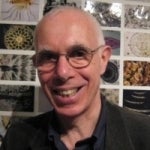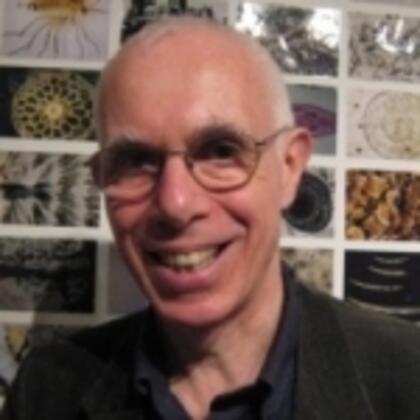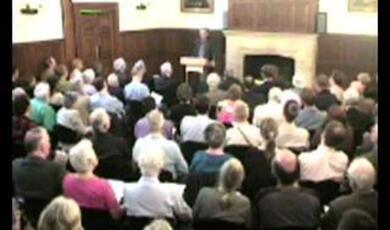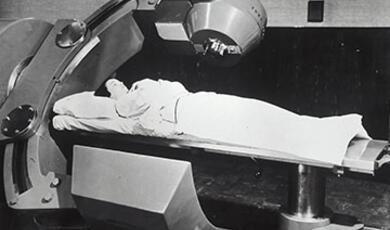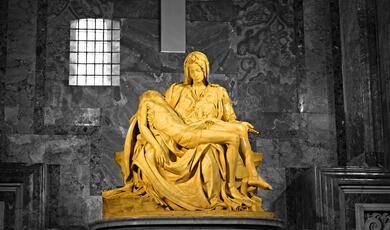A Symposium to mark the 350th anniversary of The Royal Society, examining the early days of Wadham College, Gresham College and The
Royal Society, together with the life and work of some of the founders of The Royal Society.
This second part of the conference includes the following talks:
Early Mathematical Instruments by Dr Jim Bennett, Director of the Museum of the History of Science, University of Oxford
25 November 2010
Early Mathematical Instruments
Dr Jim Bennett
When the invitation came to speak today on ‘Early Mathematical Instruments’, my first thought was that the early Royal Society didn’t have very much interest in mathematical instruments, in the well-established meaning of the term in the 17th century. This was the Royal Society of London for the Improvement of Natural Knowledge, which was not the same thing. But then I thought that, well I have only 25 minutes towards the end of the day, so the audience might not be too devastated if there isn’t a great deal to say. And then, more positively, well there might be more to say than I imagine at first, and even the relative lack of interest in an area that we might think of as central to science and its history could itself be significant.
First, what was meant by ‘mathematical instruments’ in the 17th century? – a term with a much longer pedigree than ‘experimental natural philosophy’. The Royal Society were certainly interested in instruments but mainly the new-fangled optical instruments – the telescopes and microscopes – and the even more recently fangled instruments of natural philosophy, such as air-pumps or electrical machines. Mathematical instruments were much older, with an active tradition of writing and publishing as well as making, and large numbers of specialist craftsmen in manufacturing centres regulated by guilds and companies. Optical instruments and instruments of natural philosophy could be used in making discoveries about the natural world, making experimental investigations that might yield new natural knowledge. Mathematical instruments had no such ambitions – they were for solving problems that were amenable to mathematic techniques, especially geometry – for finding the time or the positions of the planets, for surveying land or drawing a map, for navigating a ship, for designing a building, for finding the distance of an artillery target and setting the charge and the inclination of the gun to hit it, and so on – many fields of application had been development for instruments such as sundials, astrolabes, quadrants, theodolites, maps, globes, rangefinders, inclinometers, and so on – but they did not interfere with natural philosophy. While this was a limitation to their competence, it was also a source of freedom in their design and use. They did not need to conform to the strictures of natural philosophy. My favourite example of this is that terrestrial globes rotate on polar axes before Copernicus proposes in 1543 that the earth might actually be doing the same. Such globes do not represent anticipations or precursors of the Copernican system of the world; they simply offered a convenient device for dealing with calculations relating time, date and geographical position.
A characteristic element in contemporary practical mathematics, the place where you find mathematical instruments, was what was called the ‘theoric’. A theoric was an encapsulation of information, secured by a systematic technique (usually a geometrical one), in a device that might be an instrument but could also be a diagram or a construction. Results could be obtained from the theoric that were not entered in its construction and that were extracted by the operation of proper protocols by the knowing user. The example most familiar to historians is the theoric of planetary motion – a geometrical construction using combinations of circles for predicting, or retrodicting, planetary positions – but mathematical practice has many other examples in different disciplines. As the vehicle for an operative technique rather than a causal explanation, the theoric belongs in the mathematical arts and sciences rather than in natural philosophy; it does not make the epistemological claims of natural philosophy regarding the true understanding of nature. The geometrical cartography of the 16th century, for example, offered world maps that took a variety of forms, shaped by different geometrical projections, and these varieties could co-exist, to be deployed according to their suitability for different purposes.
Keeping in mind this contemporary meaning of ‘mathematical instrument’, we will not find much of relevance in the early deliberations of the Royal Society. We can be sure that certain mathematical instrument makers were known to certain fellows – we know, for example, of Hooke and Wren employing them. In bringing Oldenburg up to date with news of plague-ridden London in 1665, Robert Moray wrote ‘we all here are much troubled with the loss of poor Thomson & Sutton’ – Anthony Thomson and Henry Sutton, two of the capital’s finest mathematical instrument makers.
In fact I want to take this opportunity to demonstrate just how outstandingly good the best of the London makers could be at their trade. Henry Sutton was one of the most original among the makers – one with significant interests in geometry and new designs, but he may also have been the finest engraver when the Royal Society was founded. The Museum of the History of Science in Oxford we has a universal astrolabe by Sutton and also – very unusually – an early pull taken from the inked instrument.
*
What is this print for? – why was it made? – different possibilities have been suggested,.
*
But what immediately strikes you when looking at this print is its extraordinary quality – to pull such a print from so complicated an instrument seems to me an act of bravado – an assertion of self-confidence in outstanding skill. Any untidiness or unevenness of line that may not be obvious on the brass surface will immediately be revealed by the print.
*
This is fairly early as regards printing from copper plates in England. Sutton is saying that he is as good as any of the contemporary engravers.
*
*
There may some leeway with a figurative print – there is nowhere to hide faults in a detailed projection such as this.
So, mathematical instrument making has reached an impressive level of skill in the 17th century, and English mathematicians and instrument makers are introducing innovative and successful designs – some of which I’ll mention later – as well as cultivating manual skill, but this not a discipline much in evidence at the Royal Society.
Searching the early volumes of the Philosophical Transactions, I found only one article on a mathematical instrument in the contemporary sense, and it was by an alumnus of Wadham College.
*
This is Christopher Wren’s perspectograph, known to the mathematical instrument maker Ralph Greatorex, and attributed to Wren, as early as 1653. Wren described it to Greatorex, and later had one made by Anthony Thompson. Oldenburg had one. Pepys had one made for himself. Boyle had one, and there was an example in the museum of the Royal Society.
That Wren provides the instance where we can recover a link between mathematical instruments and the Wadham / Gresham / Royal Society nexus is typical of him. His engagement with practical mathematics remained distinctive from his early interest in sundials, through his activities is drawing, instrument design, geometrical astronomy, machines, surveying instruments, and so on. By the mid-1660s it was far from clear that all the promise of his precocious youth was going to lead to any lasting and substantial achievement until the architectural opportunities that came to him after the Fire of London so closely matched and engaged the range of his practical mathematical talent.
Hooke of course was the other figure whose practical mathematical interests and skills could be turned to good effect in rebuilding London, though his commitment to experimental natural philosophy, alongside practical mathematics, was profound and sustained. On the mathematical instrument side he designed surveying, navigational and astronomical measuring instruments.
Even two swallows don’t make a summer and we must return to the fact that mathematical instruments, for all their development and significance in the 16th and 17th centuries, were not prominent in the work of the Royal Society. This had emphatically not always been the case for Gresham College and its mathematical professors – for the early predecessors of Wren and Hooke in Gresham’s mathematical chairs. Wren certainly was aware of these precedents, saying in his inaugural address at Gresham in 1657 that the early professors had been ‘Men of the most eminent Abilities, especially in mathematical Sciences; among whom the names of Gunter, Brerewood, Gellibrand, Foster, are fresh in the Mouths of all Mathematicians’. The reputations of these men were certainly in practical mathematics and mathematical instruments – perhaps Edmund Gunter most of all, for Gunter’s sector
*
Gunter’s rule
*
Gunter’s quadrant
*
Samuel Foster too was preoccupied with instrument design – sundials, an improved quadrant, calculating instruments, and so on.
*
If we focus on the early Royal Society group, moving through the Wadham College period in the familiar narrative, we will see a shift in emphasis from practical mathematics to experimental natural philosophy and from a concern with developing sectors and quadrants to the invention, improvement and deployment of telescopes, microscopes, barometers and air-pumps. This development is a connected narrative, not an arbitrary sequence. The problems confronted by the new philosophy were inherited from the inadequacies and dilemmas of the old; the ambitions and agendas of the new philosophy were influenced by visionary, programmatic thinkers. But the qualities and characteristics of practical mathematics were an important resource for the emerging experimental mechanical philosophy – mathematics as a tool of synthesis, mechanics as a paradigm mode of causal operation in the natural world as well as the artificial one, manipulative, operative knowledge as a resource for the experimental approach to natural philosophy, and instruments as the tools and embodiment of this experimental engagement with nature.
The story of Gresham College itself, from the practical mathematics of Gunter to the experimental philosophy of Hooke is an institutional strand in the same narrative. As early as the mid-1640s, when Foster was still in post and John Wallis was becoming involved, what Wallis remembers being discussed are:
the Circulation of the Bl{ood}, the Valves in the Veins, the Copernican Hypothesis, the Nature of Comets, and New Stars, the Satellites of Jupiter, the Oval Shape (as it then appeared) of Saturn, {the} spots in the Sun, and its Turning on its own Axis, the Inequalities and Selenograp{hy} of the Moon, the several Phases of Venus and Mercury, the Improvement of Telescopes, and grinding of Glasses for that purpose, the Weight of Air, the Possibility or Impossibility of Vacuities, and Natures Abhorrence thereof; the Torricellian Experiment in Quicksilver, the Descent of heavy Bodies, and the degrees of Acceleration therein;
So, there is mathematics but there is a strong shift towards natural philosophy.
When Wren writes from Wadham College in February 1656/7 – probably to William Petty – giving him what he calls the ‘Philosophical News’, his dioptrical work includes the anatomy of the eye, alongside the improvement of microscopes and telescopes; he reports a micrometric survey of the moon, which involved adapting traditional instrumental measurement to the astronomical telescope, alongside a study of the earth’s magnetic variation; anatomical dissection for which he is providing the drawings, and experiments in intravenous injection.
And the trend continues as the Royal Society institutionalises an emphasis on natural knowledge. But of course, all the while, the world of mathematical instruments continues to develop and the English makers continue to improve and flourish – we have seen the level of skill achieved by Henry Sutton – and new textbook writers emerge to explain how the instruments are used and the geometrical techniques applied to practical ends. Practitioners still need to find the latitude, the time, measure land, draw maps, and so on. You need only visit the Museum of the History of Science to see that the material remains of science from the 17th century comprise quadrants, sundials, artillery and surveying instruments, sectors, rules and slide rules, rather than air-pumps and electrical machines. The makers were operating successful businesses, with workshops, reception spaces, even demonstration spaces, items in stock, items to order, and so on.
Indeed when the Royal Society proposes to keep a ‘stock’ of experiments, which in effect means a collection of natural philosophical instruments, it’s hard not to think that the instrument shop, as it was managed in the 17th century, was as much a model as the very few collections of natural rarities. We see this happening, in real time, so to speak, at a meeting in December 1673, when Hooke was showing an experiment on the relationship between magnetic attraction and distance.
Upon this occasion Sir William Petty moved, that the Society would give orders, that there might be a constant apparatus of instruments ready for the making of several kinds of experiments depending on several heads; for instance, for experiments of motion, optical, magnetical, electrical, mercurial, &c. And that such instruments, as had been formerly used by the Society, and were out of order, might be repaired, and all these put together in a room by themselves, to be ready upon occasion for strangers, or for repetition and farther prosecution of the several sorts of experiments.
An extraordinary statement – proposing just the kind of cabinet of physics that would become so popular among institutions in the 18th century, and setting out its main divisions – optical, magnetical, electrical, and so on. And of course the emphasis in this stock of instruments is very much in natural philosophy, even though the proposal is shaped by a former surveyor and designer of ships.
I want to conclude with one residual instance of the methodology of practical mathematics – one instance of survival within the Royal Society. It does not concern an instrument directly but a theoric – the characteristic synthesising tool of practical mathematics, and in fact a theoric that takes its form from an instrument, in a kind of analogy. We have seen that Wren was perhaps temperamentally and intellectually, and eventually certainly professionally engaged with practical mathematics and mathematical instruments.
Wren had been active at Gresham College, with his colleague there Lawrence Rooke, in experiments on the collisions of bodies prior to a visit by Christiaan Huygens in 1661, when Huygens used his account of elastic impact to predict – correctly – the results of their experiments. This looks like an obvious candidate for an study in experimental natural philosophy. Wren and Rooke has used, they said, ‘balls of wood and other stuff hanging by threads’ – frames of this sort were later included in standard cabinets of physics – while the overall context for the discussion was the laws of impact enunciated by Descartes in his ‘Principles of Philosophy’. Mechanical impact was to be the basis of Cartesian natural philosophy and the fundamental ingredient in its causal explanations, but Descartes’ actual laws seamed seemed very dubious and in need of correction.
Wren formulated his own theory of impact soon afterwards, but the disappointment with it among his colleagues was understandable. Everyone agreed that it predicted the experimental results and produced the same results as that of Huygens, but it seemed to lack the appropriate ambition in natural philosophy – Wren had stopped too soon – at the formal expression of his results – and did not go on to offer a demonstration or explanation. When that was pointed out to him, Wren averred that he was finished – that that was it – that was all he planned to do – ‘he is against’ it was reported, ‘finding a reason for the experiments of motion ... and says that the appearances carrie reason enough in themselves’. Wren’s theory would more properly have been called a ‘theoric’.
It took the form on an analogy with the balance. Consider the ‘bodies’ (we might say ‘masses’ but that would be anachronistic) as the weights on the balance and their velocities as the distances of the respective weights from the fulcrum. Wren’s analogy reduced all the experiments to only 2 general cases. One is when the balance is in equilibrium, the velocities are inversely proportional to the respective bodies, the centre of gravity coincides with the fulcrum of the balance. In that case the velocities are unchanged after collision except that their directions are reversed. The collision is ‘balanced’. Where this is not the case, where velocities are not inversely proportional to bodies and the centre of gravity of the imagined balance does not coincide with the fulcrum, the situation after collision is represented by displacing the fulcrum to an equal distance on the other side of the centre of gravity.
As with any theoric, this is a formalisation of a set of observations that can be used to yield any number of results not included in the work of formulation – in that way it is like a geometrical construction of planetary motion (one has to say a non-Keplerian construction), a map drawn to scale, or any number of mathematical instruments. In refusing to offer an explanation Wren was, at that point, declining to go with the mainstream ambition of the Royal Society. As William Neile put it:
... for Dr Wren I think he assumes his axiome a great deale sooner than he need to doe ... to conclude that the aparence is the reality and that the aparence must not be denied to vbe really true under pretence that it is an axiome meethinks is not very philosophicall.
As I said, for that moment, Wren was not following the Royal Society into experimental philosophy, but he was in an older tradition – among sectors, globes, astrolabes and the great population of mathematical instruments.
© Dr Jim Bennett, 2010


 Login
Login
